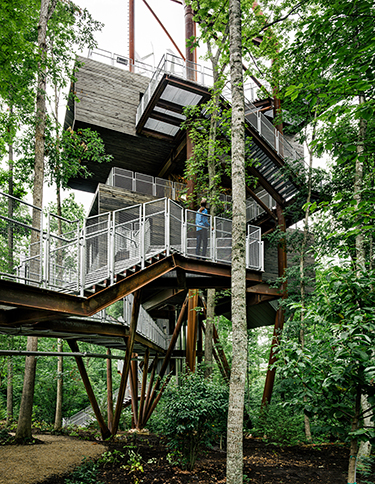|
Subscribe / Renew |
|
|
Contact Us |
|
| ► Subscribe to our Free Weekly Newsletter | |
| home | Welcome, sign in or click here to subscribe. | login |
Architecture & Engineering
| |
January 15, 2014
Mithun's treehouse teaches by example
Journal Staff Reporter
It's one impressive treehouse.
The 125-foot-tall, 3,400-square-foot structure at Summit Bechtel Reserve in West Virginia is surrounded by a canopy of trees.
It is supported by a corten steel frame engineered by Tipping Mar and comes with 2,500 square feet of outdoor platforms.
Seattle-based Mithun was the design architect for the treehouse. Trinity Works, a Fort Worth-based corporation, developed it for the Boy Scouts of America and Swope Construction built it.
The treehouse is a hands-on sustainability education center used by the Scouts and visitors to the reserve, which is a high-adventure base camp.
The treehouse opened last year for the National Scout Jamboree, which attracted tens of thousands of Scouts.
The idea for a treehouse came out of a design charette.
“Many of us are former Scouts, so I think a lot of us were channeling our inner childhood,” said Brendan Connolly, a partner with Mithun.
During the two-week charette, a group of firms that included Mithun created a master plan for the reserve, which is a 10,000-acre former mining and logging area owned by the Scouts.
The master plan focused on 250 acres where visitor facilities, mountain bike trails and a zip line are planned to go with the treehouse. More than 30 dining, educational and residential buildings will be constructed over the next five to 10 years in the area.
Connolly called the treehouse “a very powerful experience in the forest canopy.”
The structure involved a collaboration between architects and engineers. It is used to teach about sustainable design and environmental stewardship through experiences such as climbing and perching in the trees and seeing nature from new vantage points.
The indoor and outdoor spaces have interactive exhibits, such as a tippy-cup rain chain and a wheel of sustainability, which encourages visitors to consider the effects their actions have on the environment. Visitors also may use a stationary bike to power an incandescent light.
The team is aiming for certification under the Living Building Challenge.
The treehouse harvests its own energy and water via a 6,450-watt photovoltaic array, two 4,000-watt wind turbines, and a 1,000-gallon cistern and water cleansing system. It also has composting toilets.
The Scouts has originally planned a building with 20,000 square feet, but Mithun suggested going smaller to minimize the impact on the environment, said Susan Olmsted, a senior associate with the firm. “We actually just put it on a diet.”
The design was inspired by the structures miners once built on sloped sites, Olmsted said, “and then of course the idea of being a kid.”
The treehouse won an honor award last year from the American Institute of Architects Seattle chapter.
The project team also included BNIM, executive architect/architect of record; Nelson Byrd Woltz, landscape architect; Tipping Mar, structural engineering; Integral Group, MEP engineer; Volume, Inc./ Studio Terpeluk, exhibit design; Dave Nelson & Associates, lighting design; S&ME, geotechnical; and FP&C Consultants, code consultant.
Mithun has designed other environmental eduction centers, including IslandWood on Bainbridge Island that has two treehouses.
Lynn Porter can be
reached by email or by phone
at (206) 622-8272.



